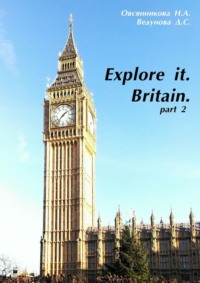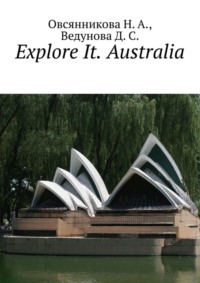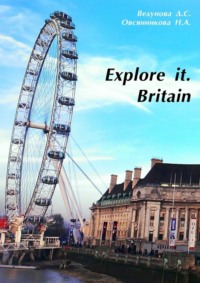
Полная версия
Explore it. The USA
Depending on the nature of the mountain systems, weather stability also changes markedly: in low Appalachians the climate differs little from the flat areas of the east of the country and is quite constant, while the extensive and high ridges of the Cordillera system are widely known for their cooler, dry and unstable weather.
The nature of the distribution of precipitation is also very uneven. In the southeastern states and on the Pacific coast, it drops to 2000 mm of rain per year, in the Hawaiian Islands – up to 4000 mm and more, while in the central regions of California or Nevada – no more than 200 mm. And the nature of the distribution of precipitation depends entirely on the terrain – the western slopes of the mountains and the Atlantic regions receive significantly more rain than the eastern ones, while in the entire Great Plains, from the coastal lowlands of the south to the wooded areas of the north, there is almost the same amount of precipitation 300—500 mm).
At any time of the year, you can find the US region, where rest would be comfortable in its weather conditions. The swimming season in the north and in the center of the Atlantic coast lasts from June to August-September, although to quite acceptable values the water warms up in May and in October. On the coast of Florida you can swim practically all year round (the average temperature of the water even rarely falls below +22° С even in winter months), however in the period from July to September it is quite hot (+36—39° С) and very high air humidity (up to 100%), and from June to November, tropical hurricanes are not uncommon.
The Pacific coast has a noticeably larger difference in water and air temperatures between the northern and southern regions. In the southern part of the coast, you can swim practically all year round, although in the period from November to March even in California, the temperature of the water rarely rises above +14° C (many seas with well-heated water are used for sea recreation). At the same time in the north, in Oregon and Washington, even in the summer months, there are often noticeable cold snaps of both water and air, in winter the temperature regime is quite common for regions with a temperate marine climate (air from -6 to +4° C, water – about +4° C). Contrary to popular belief, Oregon’s climate is dry enough (rain falls less than in Atlanta or Houston) and warm enough (summer highs rarely exceed +30° C, and in winter the thermometer remains at +2° C). Therefore, you can find excellent opportunities for recreation almost all the year round.
To the north, in the state of Washington, two distinct climatic zones, west of the Cascade Mountains, on the Pacific coast and in Seattle, quite clearly distinguish themselves, in the summer, it is rarely hotter than +26° C, and in the winter – colder +8° C, while the eastern part of the staff has a noticeably warmer summer and a cool winter. Traditionally, the summer tourist season here begins with Memorial Day and continues until Labor Day, and even some of the sights are open to visitors only during this period.
The central mountain areas can be visited all year round, in the southern part of the Rocky Mountains in the summer it is too hot (+26—34° C), therefore it is recommended to plan your trip for the spring or autumn. To avoid the influx of tourists, it is recommended to plan visits to national parks, for example, in late autumn or early spring, when the weather conditions are quite comfortable. The western slopes of the Rocky Mountains and the eastern part of California during the summer are also not very pleasant to visit – too hot, however, the seaside part of the same California at this time has quite pleasant weather conditions.
There are no seasonal restrictions for visiting Los Angeles. Despite its dry and hot semi-desert climate, the city is protected from the burning heat by mountain chains in the north and east, as well as by the Pacific Ocean itself. August and September are the hottest months (+24—30° C), January and February are the coolest (around +12° C) and the wettest, but at any time of the year ocean breezes soften the weather in the direction of greater comfort. However, the city smog combined with the summer heat makes the end of the summer not the best time to visit the metropolis, while the resort areas adjacent to it from the north and south have excellent weather conditions during this period.
The climate of Alaska is quite severe, since 30% of its territory is beyond the Arctic Circle. In northern and central regions with their subarctic climate, the thermometer’s column often drops to -45-50° C in winter, while in summer the air warms up to +16—20° C (in northern regions – +2—6° C) with very low precipitation (about 250 mm per year). In the southern and central regions the climate is temperate marine, the average temperature here in the summer is about +18° C, but often the air warms up to +30° C), in winter – from -6° C to +4° C, precipitation falls from 400 to 600 mm per year.
The vegetation of the USA
Through the territory of the United States there are various climatic zones, and in some parts of this vast country there is a truly unique microclimate in which an amazing plant world has formed.
Of course, the economic development of the North American continent played a role, however, rather large areas, about 30%, are now covered by forests. In general, coniferous species predominate – spruce, pine, fir. In the north-east of the country there are massifs of mixed forests, where, in addition to coniferous trees, grow oaks, maples, plane trees, birches, ash trees, sycamore. In the Mojave Desert, there are also original forests – cactus. In Alaska, the most northerly state of the USA, only mosses and lichens grow, in deserts and semi-deserts – shrubs, yucca, wormwood, quinoa, in alpine and subalpine meadows – heather and other flowering plants. Closer to the south, there are magnolias and rubber trees, on the coast of the Gulf of Mexico – mangrove forests, on the west coast – citrus trees, and in Hawaii – tropical jungles with palm trees, lianas, orchids and other exotic representatives of the flora. Vegetation of national parks and reserves is also unique. In the Yellowstone National Park, which has existed for more than 130 years, there are 1,870 plant species, of which the predominant majority are native species.
Most of the forests of the park are filled with pine conifer. In the undergrowth there are deciduous trees: birch, willow, aspen. In the Everglades National Park, more than 2,000 plant species are represented (different species of mangrove, mahogany, oak, willow, cypress, pine etc.). Also here are preserved in their original form tropical marshes with 25 species of orchids.
In the Zion National Park, there are mixed and coniferous forests, desert and coastal vegetation – only 450 species. In the Yosemite National Park, there are 1600 plant species, of which 160 are endemic. Next to it is broken the Sequoia park, where the tallest trees in the world grow. The highest sequoia called «Hyperion height» has a height of 115.5 meters. The northernmost part of the rain forest in the world is located in the Olympic Park. It is also the wettest area on the mainland of the United States.
Fauna of the USA
The rich fauna of the United States is mainly due to the vast expanses and careful protection of nature, which already had to suffer a lot of troubles from man.
The animal world of the US, although it has some similarities with the European one, however, there are unique animals on the North American continent. To the common animals with Eurasia one can include deer, moose, wolf, hare, sable, ermine, wolverine, woodpeckers, owls, etc. Unique North American animals are porcupines, martens ilka, large flying squirrels, red squirrels, etc.
The nature of the animal world is mainly determined by climatic conditions and vegetation. In broadleaf forests, black bears (baribals) and grizzly bears, virgin deer, red lynx, cougar, possums, skunks, chipmunks are common. In mixed forests live brown bears, lynxes, martens and wolverines. Alaskans arrange seals and walrus rookeries. In the steppes, in addition to large artiodactyls (bison, deer, vilorogie antelope, thick-legged sheep), there are foxes, coyotes, badgers, ferrets. Bison was mercilessly exterminated by man for the sake of valuable skins, but at present they are under the protection of the law. Deserts are inhabited mainly by small mammals (marsupials, etc.), reptiles (snakes, lizards, iguanas), as well as insects (scorpions, spiders, etc.). In the tropical forests of the Gulf Coast there are crocodiles and alligators, as well as anteaters, porcupines and marmosets. In the reservoirs live nutria, muskrats, beavers, as well as amphibians – frogs, toads, newts.
Birds living in the United States are very diverse. In the middle latitudes you can observe owls, vultures, eagles, mockingbirds, cranes, snipe, peregrine falcon, cormorants. In the south of the country there are more exotic species – parrots, flamingos, pelicans, hummingbirds.
The fish world is mainly represented by salmonids – only in the Yellowstone reserve are 18 species. Near the Hawaiian Islands, 600 species of tropical fish adjoin the turtles.
Save a huge species diversity of the animal kingdom of the United States help the extensive national parks and reserves. The largest species diversity of mammals, birds, fish and insects can be found in the national parks of Yellowstone, Everglades, Zion (about 300 bird species), Bryce Canyon (60 mammal species and 160 bird species), Santa Ana (the largest bird sanctuary). In the world-famous Yellowstone Reserve, the largest populations of bison, grizzly bears, pumas and wolverines have been preserved. In the Everglades National Park, where tropical marshes are preserved, there are co-existing Mississippian alligators and sharply crocodiles, as well as numerous bird species, including exotic ones.
Natural wonders of the USA
1. GRAND CANYON
One of the most unusual, deep and beautiful canyons of the world more than deserves a visit. It is located on the territory of the National Park of the same name in Arizona and attracts about 4 million tourists every year. We recommend climbing the observation deck «Grand Canyon Skywalk», which provides an excellent overview of this natural wonder – not least thanks to the glass floor. The main thing – not to dizzy, because the depth of the canyon in some places reaches 1800 meters.
2. NIAGARA WATERFALL
One of the most beautiful and majestic waterfalls in the world is a must on the list of «must see» American natural attractions. There is nothing to talk about here, because this is a beautiful sight to see with your own eyes.
3. THE DEATH OF DEATH
The place is not for the faint-hearted, and it’s not just a rather ominous name. This is an incredibly hot place, where the highest temperature in the world was recorded at one time, so it’s better to plan a visit to the Valley from November to February, when it’s cooler here. It is here that the famous Moving Stones are located, in addition, thanks to a truly alien landscape, here were shot episodes of many films, including the fourth part of the «Star Wars».
4. THE MAMMONT CAVE
In fact, this is a whole cave system, which is considered to be the longest in the world, so if the speleologist is drowsy in you – here. To the mammoths, this cave, which appeared as much as 10 million years ago, has no relation – this name appeared due to the play of words in the English language, according to which one of the meanings of the word «mammoth» is huge. Earlier on the underground river Echo, which is located on one of the lower levels, excursions were conducted on boats, but now this practice is a thing of the past. Although this underground kingdom may seem somewhat eerie, it definitely has a unique beauty.
5. FLY GEYSER
Fly is a geyser that has become one of the most famous in the world, despite the rather small height, which jets of water rises (it is only 1.5 meters). The geyser is surrounded by very beautiful stone formations, the color of which, due to mineral layers and algae, is very unusual, and represents a single natural ensemble.
6. LAKE CASCO
Lake Caddo Texas
Considering the photos of this unusual lake, you might think that it is straight from a mystical film – it has such an unusual atmosphere. The labyrinth of the channel, surrounded by rare Arizona cypresses, attracts travelers: when going for a walk along this water system, it is worthwhile to be cautious, because sometimes people are lost here (however, they are found alive and unharmed). At first sight, because of the countless number of water lilies and covered with duckweed lawns, Caddo resembles a swamp, but the water here is clean and fresh, and the natural complex is very beautiful.
7. THE SCREEN LAKE
This lake is the deepest in the United States, and its distinctive feature is the perfect round shape. Its presence is explained by the fact that the lake is located in the crater of an inactive volcano, which, however, can not be called completely extinct.
8. THE WHITE DESERT
From other deserts, this is distinguished by an amazing white color – because almost entirely this area consists not of sand, but of… gypsum! There are very few gypsum deserts in the world, and White can be rightfully considered one of the most beautiful.
9. THE LENGTH OF MONUMENTS
In this valley, not one miracle of nature is collected, but many miraculous monuments, so similar to the bizarre castles and unearthly structures of stone. They appeared due to a change in the landscape – when there was a sea, at the bottom of which slate accumulated, but after a sharp change in the earth’s crust, land was formed instead of water, and with it intricate stone figures over which sand, wind and precipitation work.
10. THE ETERNAL RAINBOW
This rainbow does not appear after the rain – it is carved from stone, and has been on the American soil for many, many years. For the Navajo Indians, it was a sacred place, and they can be understood. The wide stone bridge really shimmers with all the colors of the rainbow, representing an unforgettable sight.
The population of the USA
The population of the United States as of April 2015 was 325.7 million people. For ten years (from 2000 to 2010), the US population increased by 9.7%.
The population density is 34 people / km² (2015). Urban population – 81.4% (2014)
The US population is very diverse on ethnic and national grounds, so the US is reasonably called the nation of immigrants – from 1790 to 1994. almost 64 million immigrants arrived from Europe, Latin America, Asia and Africa.
August 1, 1790 – the first federal census of the US population, which resulted in a population of 3.9 million people.
In 1915 there were 100 million people in the United States.
In 1967, the US overcame the threshold of 200 million people.
According to the US Census Bureau, on October 17, 2006, at 7.46 Eastern Time, a 300 million inhabitant was born in the country.
308 million 745 thousand 538 people lived in the United States according to the Universal Population Census in April 2010. This is 9.7% more than during the previous census, which took place in 2000. The population of the United States of America as of January 1, 2016 is 323 341 000 people.
The American nation is a relatively young, formed during a long cultural, economic, social and domestic interaction, as well as confusion and assimilation of descendants of people of different ethnic origins, representing all three major races of mankind – Mongoloid, Caucasian and Negroid.
The racial makeup according to the US Census for 2010.
Ethnicity Number Percentage
Americans 308 745 538 100.00%
White Americans 223 553 265 72.40%
African-Americans 38 929 319 12.60%
Americans of Asian descent 14 674 252 4.80%
Native Americans or Native Alaskans 2,932,248 0.90%
Indigenous Hawaiians or other inhabitants of Oceania 540 013 0.20%
Some other races 19 107 368 6.20%
Two or more races 9,009,073 2.90%
States of the US.
One of the largest countries of the modern world, occupying the third place in terms of the number of citizens (313.2 million people) and the fourth largest in area (9.5 million sq. Km.) Among other countries, from an administrative point of view, is primarily divided into states. The US consists of 50 states, which can be called absolutely equal components of the federation, separately stands the federal district of Columbia. Each state in the United States has its own judicial, executive and legislative powers, its own constitution. In all, there are 50 states in the US, but, as of today, discussions continue on the advisability of the formation of the states of Lincoln, New York City, Superior, East Oregon and South Utah. North Virginia, District of Columbia and Puerto Rico continue to compete for a place on the list of US states. Therefore, the question of how many states in the US is slippery enough for Americans themselves, as every resident of all these so-called «51st states» wants him to become more influential and get more freedoms, along with full-fledged states USA. And it is possible that in a few years, when asked about how many US states, schoolchildren in geography lessons around the world will call a completely different figure. To date, in order for the name of a territory to be proud of as the name of the state of the USA, it will have to go through a long and complicated procedure, as well as the adoption of its own regional constitution. It is impossible to exclude or independently withdraw from the list of US states. The most populous is still the District of Columbia, and from the number of legitimate states – New York. The largest in the territory was Alaska, at one time sold by the Russian Empire to the States.
Such a complicated administrative structure has all the grounds for existence, formed both during the long history of this state, and based on economic and social benefits. The formation of a state union in the United States occurred in 1776. Then the British colonies on the territory of America announced their desire to get out of the power of the crown and form their own free state, and unleashed the War of Independence, which ended in 1783, and in 1787 the Constitution was approved, which stipulated the existing at the time names of US states. In addition to the approved list of US states, this document contained provisions on the state system, the management system, the rights and freedoms of citizens of this country, as well as its relations with the outside world. Subsequently, over the years, more and more new states were added to the United States. In the same year, there were eight states in the United States with the accession of Delaware, New Jersey and Pennsylvania. The next year was marked by the appearance of several US state names – Georgia, Connecticut, Massachusetts, Maryland, New Hampshire, New York and South Carolina joined the federation. By the end of the eighteenth century, all US states had become 16 with the foundations of North Carolina, Vermont, Kentucky, Rhode Island and Tennessee. In the following century, another 29 states were formed. On this, the question of how many states in the US did not close – at the beginning of the last century was officially proclaimed the creation of Oklahoma, New Mexico and Arizona, the latest known to date, have become Hawaii and Alaska, the accession of which occurred in one year.
Конец ознакомительного фрагмента.
Текст предоставлен ООО «ЛитРес».
Прочитайте эту книгу целиком, купив полную легальную версию на ЛитРес.
Безопасно оплатить книгу можно банковской картой Visa, MasterCard, Maestro, со счета мобильного телефона, с платежного терминала, в салоне МТС или Связной, через PayPal, WebMoney, Яндекс.Деньги, QIWI Кошелек, бонусными картами или другим удобным Вам способом.






